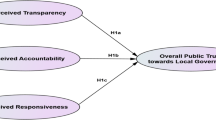Abstract
Why does bureaucratic corruption occur in the EU system? Several examples suggest that bureaucratic corruption exists and that the Commission’s anti-fraud agency, OLAF, is not a fully independent authority. We thus develop a novel interpretation of the principal-supervisor-agent model to cope with non-independent anti-fraud units. This model shows that corruption is likely to occur when the expected value to the client from bribing the agent is larger than the expected value to the principal of truth-telling by the supervisor. Overall, this analysis points to the risks of flawed incentives and the lack of institutional independence among principal, agent, supervisor and client. Our main policy recommendations as a result of these findings are that OLAF should be placed outside the Commission, and that whistleblowers should receive adequate protection.




Similar content being viewed by others
References
Baliga, S. (1999). Monitoring and collusion with ‘soft’ information. Journal of Law, Economics, & Organization, 15, 434–440.
Bjørnskov, C., & Paldam, M. (2005). Corruption trend. In J. Lambsdorff, M. Taube, & M. Schramm (Eds.), The new institutional economics of corruption (pp. 59–75). New York: Routledge.
Carozza, D. (2004). Telling the truth and living in limbo. Fraud (September-October). http://www.fraudmagazine.com/article.aspx?id=4294967831. Access date 24-11-11.
Deutsche Presse-Agentur (2011). EU parliament, anti-fraud agency bury hatchet in corruption case. Europe News, April 1. http://www.monstersandcritics.com/news/europe/news/article_1630129.php/EU-parliament-anti-fraud-agency-bury-hatchet-in-corruption-case. Access date 24-11-11.
Downs, A. (1957). An economic theory of democracy. New York: Harper & Brothers Publishers.
Europa (2011). Transparency Register. http://europa.eu/transparency-register/index_en.htm. Access date 24-11-11.
European Parliament (2003). Report on the Commission green paper on criminal-law protection of the financial interests of the Community and the establishment of a European prosecutor. European Parliament COM (2001) 715; C5-0157/2002; 2002/2065(COS); A5-0048/2003 final, 24 February.
European Parliament (2011). EP leaders agree to develop new rules for lobbyists and stronger code for MEPs. European Parliament on Institutions, March 31, 2011. http://www.europarl.europa.eu/da/pressroom/content/20110331IPR16697/html/EP-leaders-agree-to-develop-new-rules-for-lobbyists-and-stronger-code-for-MEPs. Access date 24-11-11.
European Student Think Tank (2011).Cash-for-amendments scandal rocks European Parliament. April 6, 2011. http://studentthinktank.eu/blogs/cash-for-amendments-scandal-rocks-european-parliament/. Access date 24-11-11.
EU ABC (2007a). Whistleblowers. http://da.euabc.com/word/962.
EU ABC (2007b). Schmidt-Brown, Dorte. http://da.euabc.com/word/1293.
George, S., & Bache, I. (2001). Politics in the European Union. Oxford: Oxford University Press.
Goodman, M. (1989). Preserving privilege in Yucatan. In A. J. Heidenheimer, M. Johnston, & V. T. LeVine (Eds.), Political corruption: a handbook (pp. 639–658). New Brunswick: Transaction Press.
Greenwood, J. (1997). Representing interests in the European Union. London: MacMillan.
Hodson, D. (2009). Reforming EU economic governance: a view from (and on) the principal-agent approach. Comparative European Politics, 7, 455–475.
Kassim, H., & Menon, A. (2003). The principal-agent approach and the study of the European Union: promise unfulfilled? Journal of European Public Policy, 10, 121–139.
Kurrild-Klitgaard, P. (1998). The constitutional dilemma of European integration. In A. Wivel (Ed.), Explaining European integration (pp. 270–296). Copenhagen: Copenhagen Political Studies Press.
Lambsdorff, J. G. (2007). The institutional economics of corruption and reform: theory, evidence and policy. Cambridge: Cambridge University Press.
Nielsen, J. U. M., & Svendsen, G. T. (2012). EU lobbying and anti-dumping policy. Journal of World Trade, 46, 187–212.
Office de Lutte Anti-Fraude (2011). Our mission. Brussels: European Anti-Fraud Office, European Commission. http://ec.europa.eu/dgs/olaf/mission/index_en.html. Access date 19-9-11.
Olson, M. (1965). The logic of collective action. Cambridge: Cambridge University Press.
Olson, M. (1991). Rational ignorance, professional research, and politicians’ dilemmas. In W. H. Robinson & C. H. Wellborn (Eds.), Knowledge, power, and the Congress. Washington: The Congressional Quarterly.
Paldam, M. (2002). The cross-country pattern of corruption: economics, culture and the seesaw dynamics. European Journal of Political Economy, 18, 215–240.
Paldam, M., & Gundlach, E. (2008). Two views on institutions and development: the grand transition vs. the primacy of institutions. Kyklos, 61, 65–100.
Pujas, V. (2003). The European anti-fraud office (OLAF): a European policy to fight against economic and financial fraud? Journal of European Public Policy, 10, 778–797.
Quirke, B. (2007). OLAF: the fight against EU fraud. Journal of Financial Crime, 14, 178–189.
Quirke, B. (2010). OLAF’s role in the fight against fraud in the European Union: do too many cooks spoil the broth? Crime, Law and Social Change, 53, 97–108.
Rose-Ackerman, S. (1999). Corruption and government: causes, consequences, and reform. Cambridge: Cambridge University Press.
Svendsen, G. T. (2003). Political economy of the European union: institutions, policy and economic growth. Cheltenham: Edward Elgar.
Svendsen, G. T. (2008). Lobbyisme I EU (lobbying in the EU). Copenhagen: Samfundslitteratur.
Svendsen, G. T. (2011). Evaluating and regulating the impacts of lobbying in the EU? The case study of green industries. Environmental Policy and Governance, 21, 131–142.
Tirole, J. (1992). Collusion and the theory of organizations. In J.-J. Laffont (Ed.), Advances in economic theory (Vol. II, pp. 151–206). Cambridge: Cambridge University Press.
Tullock, G. (1967). The welfare costs of tariffs, monopolies, and theft. Western Economic Journal, 5, 224–232.
Uslaner, E. M. (2009). Corruption. In G. T. Svendsen & G. L. Svendsen (Eds.), Handbook of social capital: the troika of sociology, political science and economics (pp. 127–142). Cheltenham: Edward Elgar.
van Buitenen, P. (2000). Blowing the whistle: one man’s fight against fraud in the European Commission. London: Politico’s Publishing.
Vaubel, R., Dreher, A., & Soylu, U. (2007). Staff growth in international organizations: a principal agent problem? Public Choice, 133, 275–295.
Vaubel, R., Klingen, B., & Müller, D. (2012). There is life after the commission? The Review of International Organizations, 7, 59–80.
Warner, C. M. (2003). Common market institutions, fraud and informal networks. In T. Christiansen & S. Piattoni (Eds.), Informal governance in the European Union. Cheltenham: Edward Elgar.
Xanthaki, H. (2010). What is EU fraud? And can OLAF really combat it? Journal of Financial Crime, 17, 133–151.
Acknowledgements
An earlier version of this paper was presented at the Martin Paldam Workshop, Aarhus University, September 28–29, 2012. We thank the other participants and three reviewers of this journal for helpful comments.
Author information
Authors and Affiliations
Corresponding author
Rights and permissions
About this article
Cite this article
Brandt, U.S., Svendsen, G.T. Why does bureaucratic corruption occur in the EU?. Public Choice 157, 585–599 (2013). https://doi.org/10.1007/s11127-013-0095-5
Received:
Accepted:
Published:
Issue Date:
DOI: https://doi.org/10.1007/s11127-013-0095-5




